- It's About Time
- Posts
- Seiko Revives NASA Legend Gene Kranz's Iconic Watch; Omega Shrinks Aqua Terra To 30mm; Furlan Marri Goes Back Roots; Nodus' Black Duality II; New Amida Digitrend; Credor x Artist Akira Yamaguchi
Seiko Revives NASA Legend Gene Kranz's Iconic Watch; Omega Shrinks Aqua Terra To 30mm; Furlan Marri Goes Back Roots; Nodus' Black Duality II; New Amida Digitrend; Credor x Artist Akira Yamaguchi
A hell of a lot of watches today
Hey friends, welcome back to It’s About Time. I love short and sweet newsletters, but this is the exact opposite, as you’ll see.
If you like this newsletter, I would appreciate it if you could click on an ad that might be interesting to you, it helps me keep writing these. If, however, you can’t stand ads, you can always grab the premium subscription (or here if you prefer Patreon) which removes ads and gets you four-five extra articles per week. If you’re not sure whether the additional articles are worth it, you can also get a two week free trial.
If you would like to get a premium subscription but don’t want to spend any money, you can get three months for free if you share this newsletter with five of your friends and they subscribe. Just check the end of the email for the newly-introduced referral program.
Learn AI in 5 minutes a day
This is the easiest way for a busy person wanting to learn AI in as little time as possible:
Sign up for The Rundown AI newsletter
They send you 5-minute email updates on the latest AI news and how to use it
You learn how to become 2x more productive by leveraging AI
In this issue:
Seiko Revives The Iconic Watch Worn By NASA Legend Gene Kranz
Omega Shrinks Down Aqua Terra To 30mm In 12 Different References And With New Co-Axial Movement
Furlan Marri Goes Back To Its Roots With Two New Colors On The Mechaquartz
Nodus Releases The Duality II Night Shade, A Black Super Compressor Diver
Amida Fits The Digitrend With A Sapphire Case To Show Off The Cool Internals
Credor Teams Up With Artist Akira Yamaguchi For A Very Striking Watch
👂What’s new
1/
Seiko Revives The Iconic Watch Worn By NASA Legend Gene Kranz
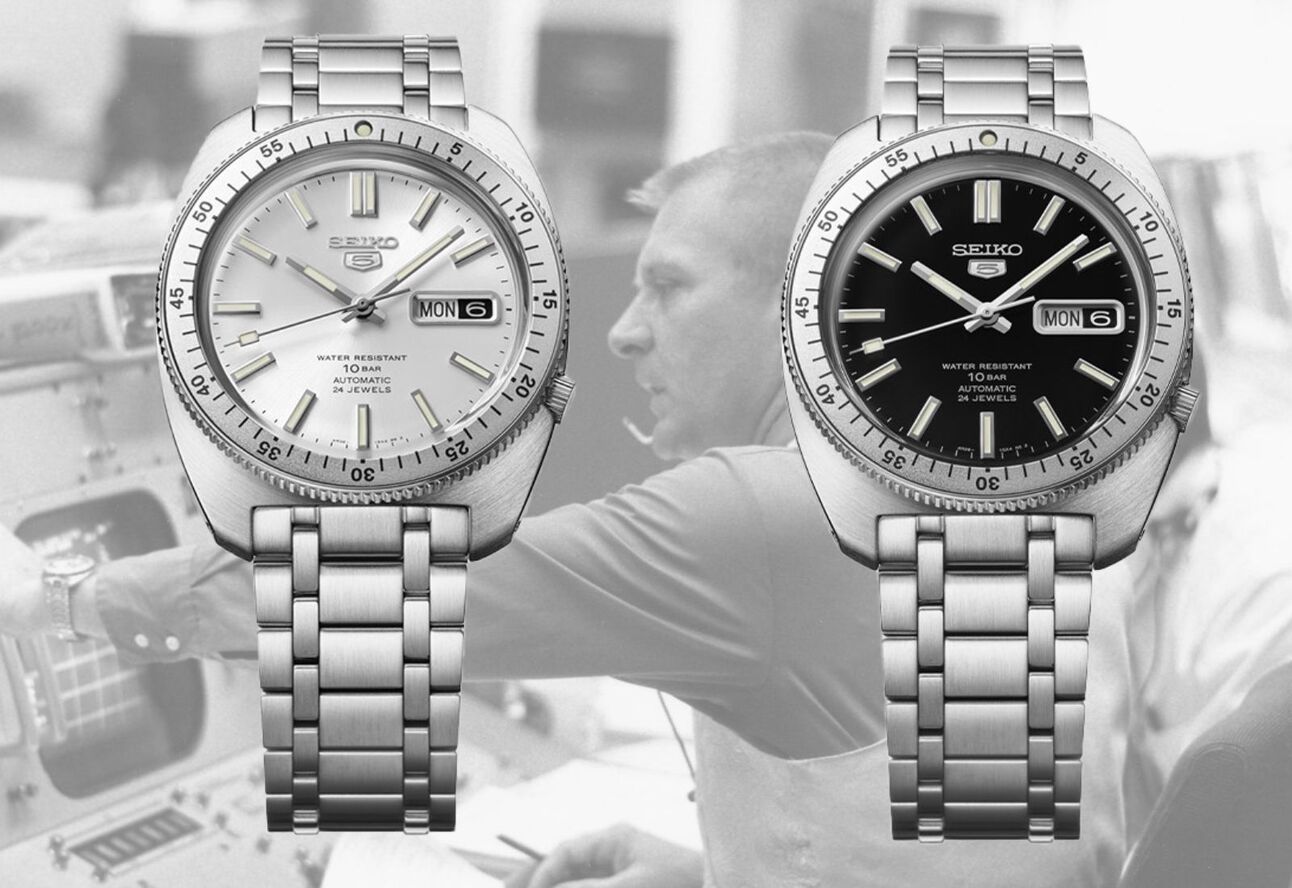
If you are a space nerd, I don’t really have to tell you who Gene Kranz is. If you’re not, then the easies way you’ll place him is — Ed Harris played him in Apollo 13. Eugene Francis Kranz, also known as Gene, is best known as NASA’s Chief Flight Director, directing Mercury, Gemini, and Apollo missions. Not only did he direct the Apollo 13 mission when everything went wrong, he was also in charge of Apollo 11, the first landing on the moon. Gene can be easily spotted in most NASA photos for wearing a bright white vest. But what’s less visible is the watch we wore, the Seiko 5 Sports 6119-8460 which has since been nicknamed the Gene Kranz. Lately, Seiko has been a spree of releasing watches that are directly inspired by legendary vintage pieces, stuff like the Kamen Rider or the Prospex Navigator Timer. Now, they’re recreating the Gene Kranz with the Seiko 5 Sports SRPL91 and SRPL93.
The case takes huge inspiration from the Gene Kranz, taking on a cushion shape and measuring a very comfortable 38.2mm wide, 12.3mm thick and with a 44.7mm lug-to-lug. Made out of steel, the case gets a brushed finish with polished sides and a crown at 4 o’clock. On top is a bi-directional bezel with a metal insert with an engraved 60-minute scale, surrounding a box-shaped Hardlex crystal. There’s something you don’t see every day, those Hardlex crystals are usually curved. Water resistance is 100 meters.
There are two dials available — a flat black and a sunray brushed silver options. The black gets white printings, while the silver gets black markings. Both also have day and date functions, with the date having a reverse colorway from the dial. The applied hour markers are filled with LumiBrite.
Inside is the well known calibre 4R36 which beats at 3Hz and has a 41 hour power reserve. Both watches come on steel bracelets that match the finish of the watch.
The new Seiko 5 Sports “Gene Kranz” SRPL91 and SRPL93 go on sale in July, limited to 9,999 pieces each. Price is set at €460. See more on the Seiko website here or here.
2/
Omega Shrinks Down Aqua Terra To 30mm In 12 Different References And With New Co-Axial Movement
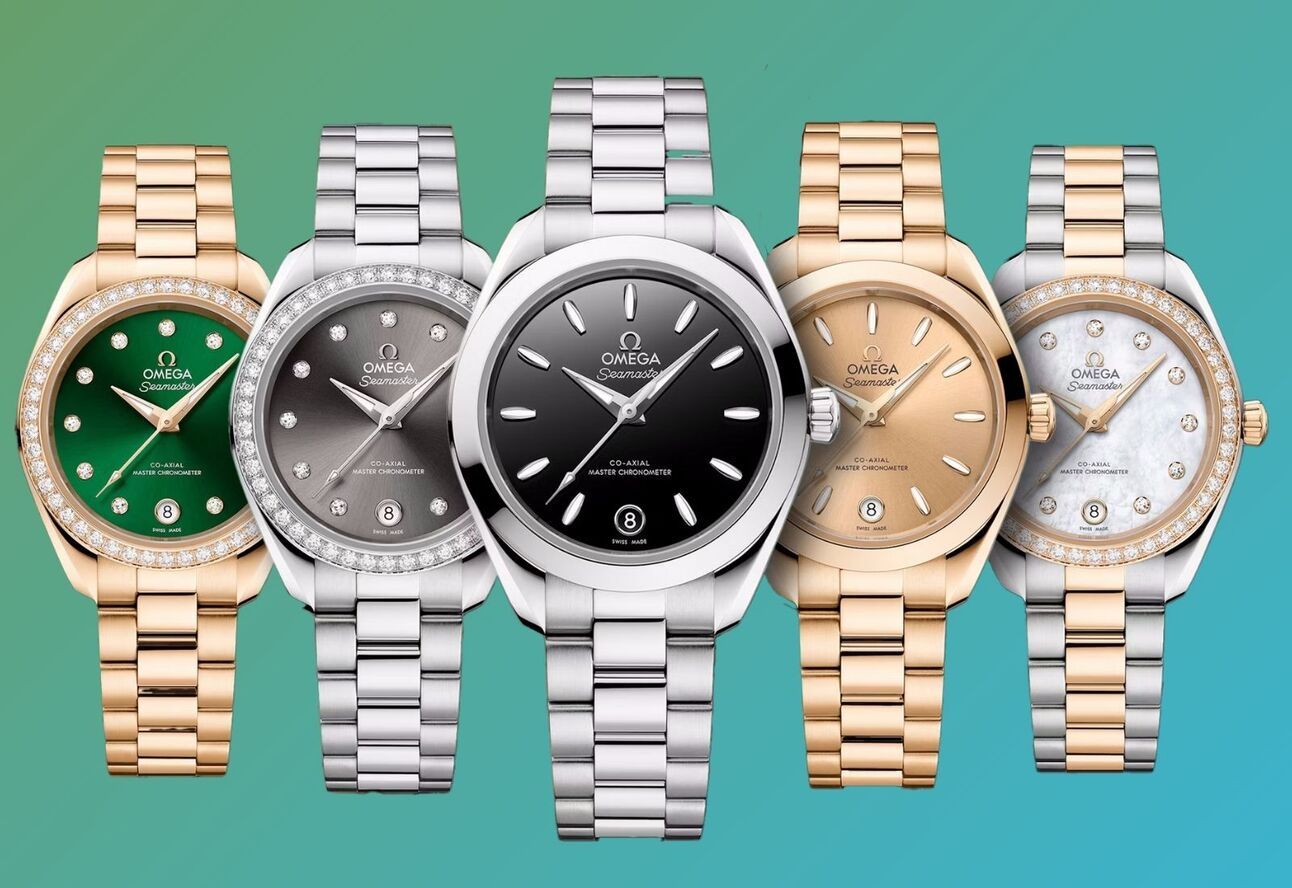
Not that any of you asked, but the Omega Seamaster Aqua Terra is one of my least favorite collections on the market, which says a lot about my dislike for the watch considering the fact that I’m a huge Omega fan. But even I can recognize a good Aqua Terra when I see one. And Omega’s latest release, 12 versions of the new Aqua Terra in a 30mm case, are much more where I see the collection. But who cares what I think, let’s get on to the new watches.
These new Aqua Terra models are tiny and while they are marketed towards women, I would love to see how the more subdued colorways look on men with small wrists. Could be interesting with watches that measure 30mm wide, 10.6mm thick (with a co-axial movement… See, Omega, it can be done) and with a 36.5mm lug-to-lug. You can choose between stainless steel, Omega’s proprietary Sedna Gold, Moonshine Gold, and bi-metallic versions, including those that have diamonds embedded in the bezel. They all feature sapphire crystals, and 150 meters of water resistance.
There’s a number of dial colors and finishes to choose from. Black, white, silver, blue and green are the more tame options, but you can opt for purple, gold, brown and mother of pearl if you want something different. All of the dials have applied markers and a date aperture at 6 o’clock.
Inside, kind of big news. Omega made two brand new movements for the 30mm watches, the Co-Axial Master Chronometer Calibre 8750 and Calibre 8751. It’s long been told that Omega can’t make a thin watch because of its co-axial escapement, and yet here we are, with movements that measure 20mm wide and 4mm thick. And these are not some under-featured movements used for the small model. No, they are Master Chronometer certified by METAS, beating at 3.5Hz, with a 55 hour power reserve. The watches come on metal-matching bracelets that feature Omega’s patented screw-and-pin construction, and a butterfly clasp with a 2mm comfort-adjustment mechanism.
The new Omega Seamaster Aqua Terra is available now, with prices ranging from $6,600 to $40,100, depending on the case material. See more on the Omega website.
3/
Furlan Marri Goes Back To Its Roots With Two New Colors On The Mechaquartz

Despite the fact that they are not one of those small indie brands that cranks out at least two new releases per day, it’s still pretty incredible to think that Furlan Marri has been around for four years. In that time, they’ve gone from a Kickstarter project to a GPHG winner. And while they make some pretty cool stuff like the Disco Volante, they often bring it back to the point when it all started, the Mechaquartz. This vintage style chronograph put Furlan Marri on the map and now they’re bringing it back with two new colors — Sabbia Rosa and Ardesia Blu.
Since these are new colorways, not much has changed on the outside. The stainless steel cases still measure 38mm wide and 12mm thick, with a 46mm lug-to-lug. The watches still feature the Tasti Tondi-style pushers, sapphire crystals and great finishes that include satin brushing and mirror polish. the Sabbia Rosa color also gets a 4N rose gold PVD coating. Water resistance is 50 meters.
The setup of the dial also remains familiar, just now matching the color in the names. The Sabbia Rosa gets a champagne dial, while the Ardesia Blu gets a dark blue. The former has a tachymeter scale on the outside, and two sub-dials — the 60 minute totalizer at 9 and the horrible 24 hour scale at 3 o’clock. The stamped roman numerals and applied hour markers both get the 4N rose gold PVD coating, as do the curved hands. The latter dial, however, swaps the tachymeter scale for a pulsometer and ditches the 24-hour scale, keeping just the totalizer at 9 o’clock. The roman numerals and markers are done in high polished steel.
Inside, you’ll find the Seiko VK64 meca-quartz chronograph which uses a quartz movement to keep track of the time, and a mechanical movement to run the chronograph. Both watches come with two straps. The Sabbia Rosa gets both a beige and a dark brown leather strap, while the Ardesia Blu gets a baby blue leather and a dark blue nubuck strap.
The new Furlan Marri Mechaquartz Sabbia Rosa and Ardesia Blu are available now, priced at CHF 585. See more on the Furlan Marri website.
4/
Nodus Releases The Duality II Night Shade, A Black Super Compressor Diver
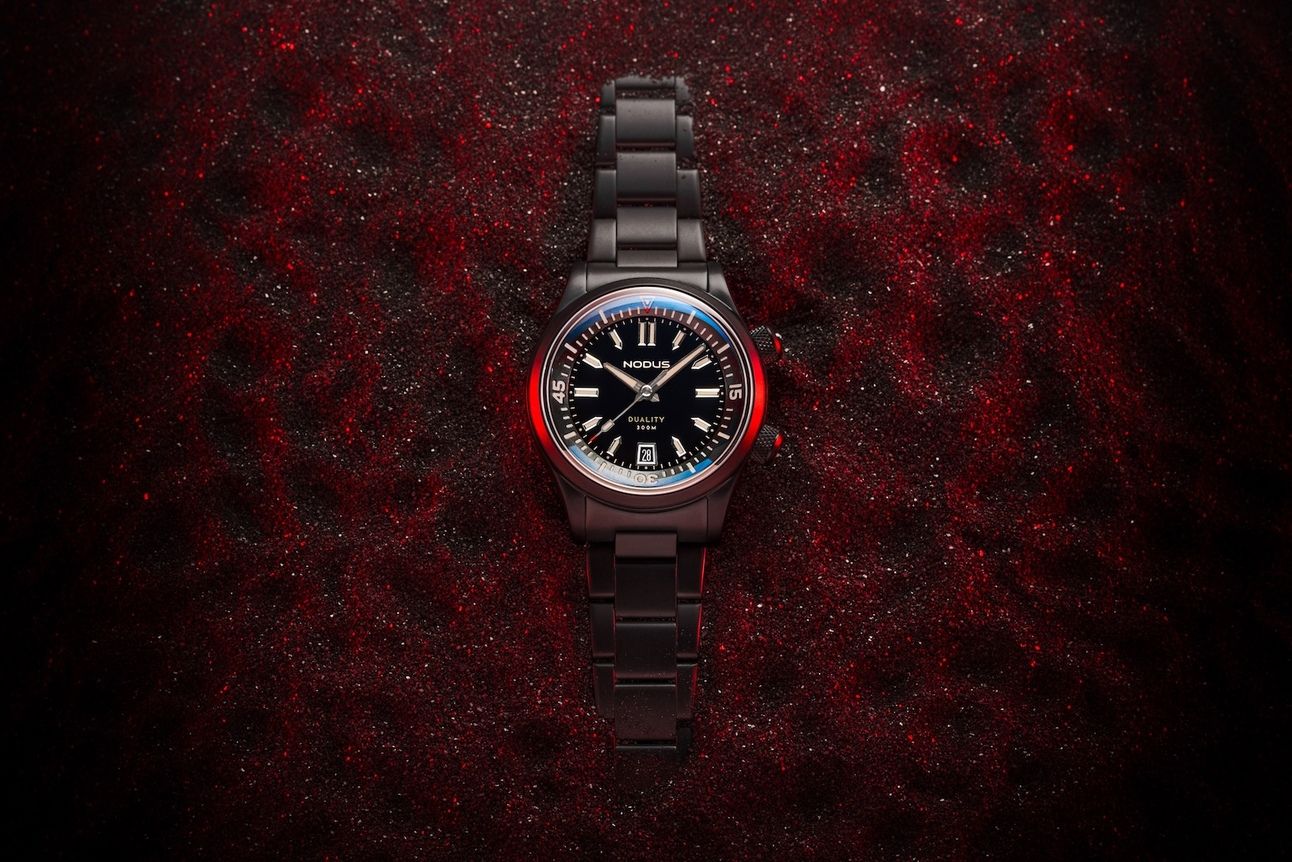
The Los Angeles-based Nodus watches has been around a bit over seven years and in that time they have managed to build up quite the cult following. And it’s easy to see why. They make great looking watches, well built and with some very cool features, at prices that are truly affordable. Every now and again, they release a limited edition, and even though most people don’t like LEs, we can easily forget Nodus because their watches are just so good. Their latest limited edition comes in the form of the Duality II Night Shade, their super compressor diver that gets a black coating.
On the outside, a lot is familiar — the twin crowns on the right side (one to operate the internal bezel, one to set the time), the stainless steel case and the size of 40mm wide and 11.5mm thick. The thickness is especially cool considering the 300 meter water resistance. That’s where the familiarities stop, since the entire watch gets a black DLC scratch resistant coating.
The black theme continues on the dial, which, along with the internal bezel, gets a matte black color, while keeping the setup of the regular Duality II. It has the faceted bar hour markers which, along with the hands, is now paired with beige Super-LumiNova that glows blue. Integrated into the 6 o’clock hour marker is the date window.
Inside, you’ll find the Miyota calibre 9015 automatic which will get you a 41 hour power reserve and mediocre accuracy. At least, you would get that if it were the stock Miyota movement. Instead, Nodus regulates the movement to +/-8 seconds per day. The watch comes on a metal bracelet that gets the same DLC coating as the case and closes with the NodeX micro-adjustable clasp.
The new Nodus Duality II Night Shade is a limited edition of 75 pieces and goes on sale today, June 18th, 9:00AM Pacific Time. Price is set at $875. See more on the Nodus website.
5/
Amida Fits The Digitrend With A Sapphire Case To Show Off The Cool Internals
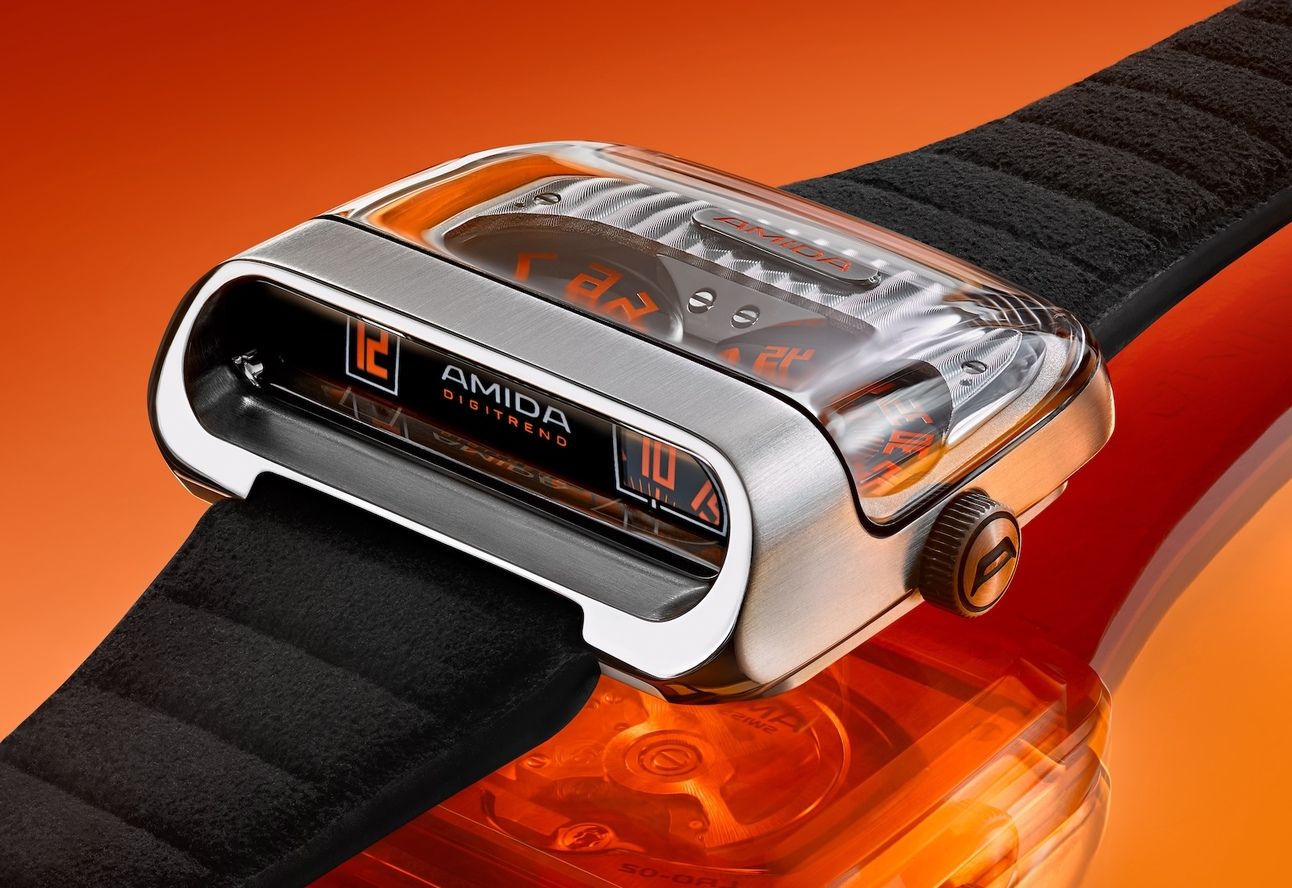
One of the coolest watches I’ve seen at Watches and Wonders in April was one I wasn’t exactly allowed to talk about. It was the Amida Digitrend Open Sapphire, a groovy take on the already cool Amida Digitrend. The Digitrend was originally released in April of last year, as a recreation of a quirky 1970s Space-Age driver’s style watch. It was a hunk of steel that has an opening on the bottom side of the watch, displaying the two digital numeral apertures which are actually sapphire prisms that reflect and twist the hours and minutes from the two rotating discs. If that sounds complicated, Amida is helping you out with the Open Sapphire model which ditches the closed cover on what would be considered the face of a watch, replacing with a sapphire crystal that allows you to see all the internals. And it completely transforms the look and feel of the watch, making it wear radically lighter on your wrist when compared to the steel, black DLC, and 4N gold PVD versions we’ve seen before.
The shape of the watch remains pretty much the same, as only the materials change. It’s a surprisingly compact watch, for how imposing it looks in photos. Just 36mm wide, it has a length (we can’t really talk about lug-to-lug here, since the entire case is one solid block) of just 39mm. It’s a thick watch - 15.6mm at the thickest point - but it also tapers down in a teardrop shape. The part around the opening for the dial and the bottom part of the watch are made out of stainless steel, brushed on top and bottom and polished around the dial. The main part of the watch is made out of a huge chunk of curved sapphire crystal, which Amida says takes 24 hours to make, and I believe it. It’s beautiful.
Through the crystal, you get to see a nicely finished plate that’s decorated with Geneva waves, faceting, stippling, and anglage and holds the Amida logo. You also see the rotating discs with the reversed numerals. Lower on the watch, you’ll find the flat black strip that acts as a dial, with two openings in the black surface that gives you a look at the sapphire prism that reverses the numbers. On the left are jumping hours while the scrolling minutes are on the right.
Powering all of this is not some exotic in-house movement, but rather the Soprod Newton P092, an automatic movement that beats at 28,800vph and has a 44 hour power reserve, with a custom module that connects the movement to the rotating . It’s even nicely finished, with rhodium-plating, sand-blasting, Geneva stripes and circular graining while the customized rotor is openworked. The watch can be had on either an anthracite Alcantara strap with an orange leather lining or a metal bracelet.
The new Amida Digitrend Open Sapphire is a limited edition of just 150 watches, which is a true shame. It goes on sale on June 19th at 4PM CET, with a price starting at CHF 4,500, without taxes, for the Alcantara strap. See more on the Amida website.
6/
Credor Teams Up With Artist Akira Yamaguchi For A Very Striking Watch
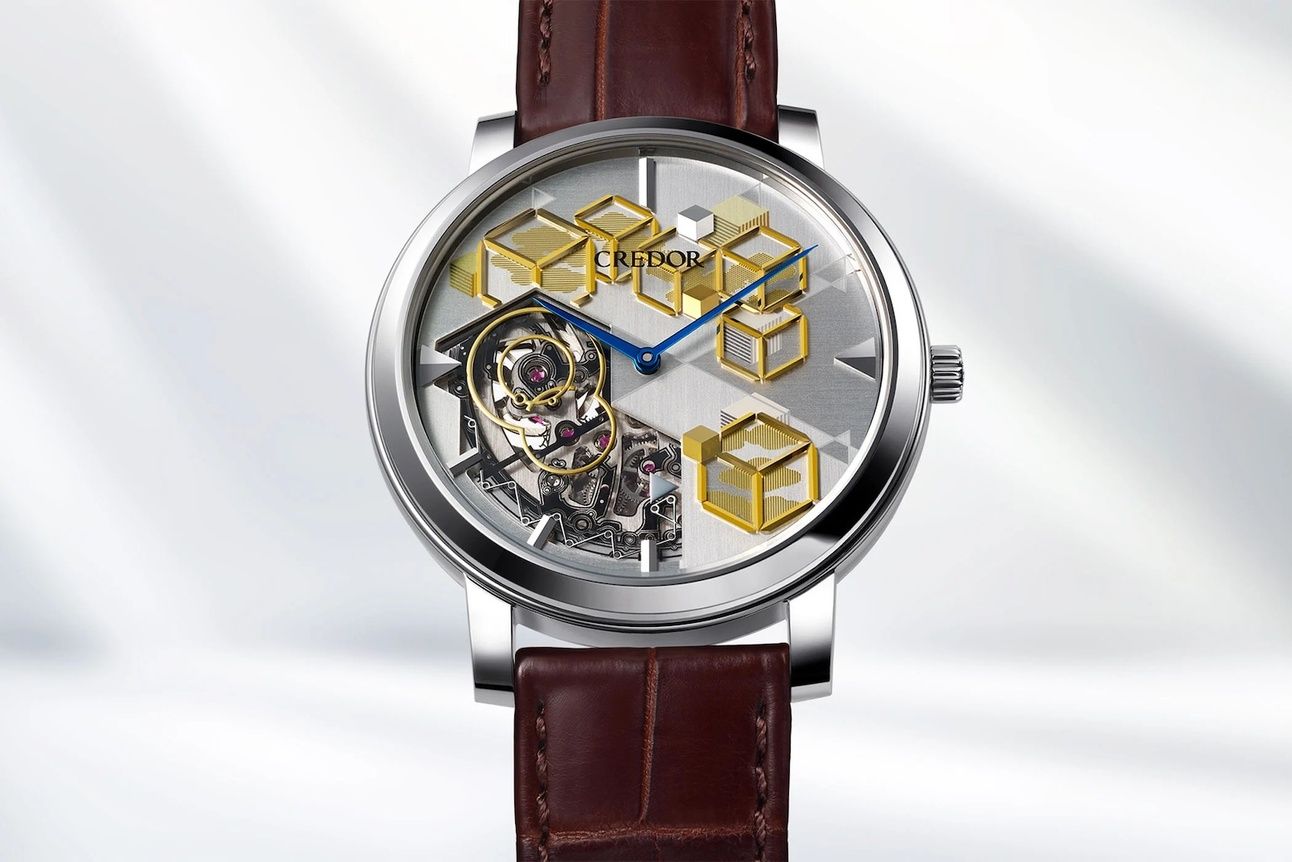
The Seiko brand name is almost ubiquitous as the Rolex name. It’s instantly recognizable, even by people who know nothing about watches and, unlike Rolex, they were likely owned by at least someone the general public knows. Grand Seiko, on the other hand, is a bit more niche. A step up above Seiko, it’s their more elegant and more expensive brand that’s not as much of a household name. GS is a watch for watch nerds. But then, there’s Credor. A bit of a mystery for even people well versed in the watch world and Seiko’s haute horology brand. Back in the late 1970s, Credor worked with legendary watch designer Gerald Genta to create one of their most iconic watches, the Credor Locomotive. Over the past few years, Credor started reinventing itself to become a serious contender in the high end space. Their latest release, the Credor GCBD997 which is made with Japanese painter Akira Yamaguchi, proves they do belong in the upper echelons of watchmaking.
The new GCBD997 comes in a stainless steel case, polished, and measuring 38mm wide and just 8.4mm thick, including the curved sapphire crystal on top. It’s a simple case, but with some very nice decorations, all of which are happening on the caseback. First, since this watch is very much about openings, there’s a small sapphire crystal that shows you just a part of the regulating organ. The rest of the caseback is engraved with an intricate geometric pattern. Water resistance is 30 meters.
The dial features a design concept called suki mechanical. Suki stands for the appreciation for the elegant and the refined. To show the elegant mechanical, the dial is open from 6 to 9 o’clock in a very interesting, slightly jagged shape. That opening is covered by a sapphire crystal, decorated with mechanical illustrations. The rest of the dial gets a base in several shades of silver, onto which Yamaguchi then places the indices. While you would usually find these around the perimeter of the dial, this watch has them arranged into six three-dimensional a rhombus pattern, a traditional pattern in Japanese painting.
Inside, you’ll find the Credor calibre 6899, based on the hand built Seiko 68 family. It’s a hand wound movement that beats at 3Hz and has a 37 hour power reserve. The watch comes on a brown crocodile strap.
Now, for some bad new — the chances of you even seeing the Credor GCBD997 are miniscule. Not only is it super limited to just 15 pieces, it will also only be sold in Japan. But it’s still a great looking watch. The price is set to JPY 3,300,000, or about €19,800. You can see more on the Credor website, which is all in Japanese.
⚙️Watch Worthy
A selection of reviews and first looks from around the web
⏲️Wait a minute
A bunch of links that might or might not have something to do with watches. One thing’s for sure - they’re interesting
For The New York Times, Kashmir Hill reports on the dark and disturbing side of interacting with AI. This unsettling story shows how ChatGPT can hallucinate and “go off the rails,” especially when engaging with vulnerable users or people struggling with mental health who seek guidance. Some people have reported that the chatbot reinforces delusional thinking, which some say is by design—facilitating conversations that keep users “engaged” and hooked.
If you’ve ever played Werewolf or Mafia, then the concept of the Iraqi game mheibes makes a certain kind of sense. One person out of 45 is holding a silver ring, and two teams have five minutes to figure out who it is—and which hand they’re holding it in. But this is no ordinary party game; it’s a grueling, multi-hour affair, with closely held trade secrets. For The Atlantic, Jason Anthony travels to Baghdad to watch mheibes masters at work and investigate why Iraqi men have developed such an astounding bullshit meter.
Who is Nathan Fielder, really? Alexandra Tanner asks the question on many TV watchers’ minds, but if you’re hoping for an illuminating look at entertainment’s consummate man of self-made mystery, this isn’t it. Because, as Tanner opines, the more interesting question—the one Fielder’s oeuvre wrestles with—is who any of us are, really.
👀Watch this
One video you have to watch today
I love these Great Art Explained In 15 Minutes videos. I especially like it when it’s about Jackson Pollock. You know, the guy that does paintings ‘your kid could do’.
What did you think of this newsletterYour feedback will make future issues better |
Thanks for reading,
Vuk


Reply